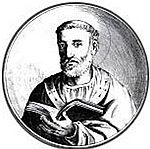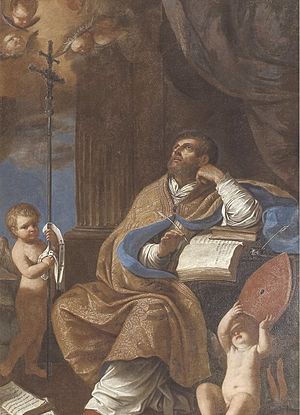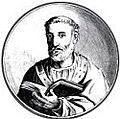Peter Chrysologus facts for kids
Quick facts for kids SaintPeter Chrysologus |
|
|---|---|
 |
|
| Bishop, Confessor, and Doctor of the Church | |
| Born | c. 380 Imola, Province of Bologna, Emilia-Romagna, North-Central Italy |
| Died | 31 July 450 Imola, Province of Bologna, Emilia-Romagna region, North-Central Italy |
| Venerated in | Roman Catholic Church, Eastern Orthodox Church |
| Canonized | Pre-Congregation |
| Feast | 30 July 4 December (General Roman Calendar 1729-1969) |
Peter Chrysologus (which means "Peter the Golden-worded") was an important leader in the early Christian Church. He lived from about 380 to 450 AD. He served as the Bishop of Ravenna, a major city in Italy, from around 433 until he died.
Peter Chrysologus is famous for his powerful and clear sermons. People called him the "Doctor of Homilies" because his speeches were short but full of deep meaning about faith. Both the Roman Catholic Church and the Eastern Orthodox Church honor him as a saint. In 1729, he was given the special title of Doctor of the Church by Pope Benedict XIII. This title is given to saints who have made important contributions to theology and doctrine through their writings and teachings.
Contents
Early Life and Becoming a Bishop
Peter was born in a town called Imola, in Italy. There, a bishop named Cornelius guided him. Cornelius baptized Peter, taught him, and later made him a deacon. A deacon is a helper in the church.
Later, Peter became an archdeacon, which is a higher role. This happened thanks to the influence of Emperor Valentinian III. Around the year 433, Pope Sixtus III chose Peter to be the Bishop of Ravenna. This was a very important job because Ravenna was the capital city of the Western Roman Empire at that time.
There's a traditional story about how Peter became bishop. It says that Pope Sixtus III had a dream. In his dream, Saint Peter the Apostle and Saint Apollinaris of Ravenna (the first bishop of Ravenna) showed him a young man. They said this young man would be the next Bishop of Ravenna. When a group from Ravenna arrived, including Peter from Imola, Pope Sixtus recognized Peter as the young man from his dream. So, he made Peter a bishop.
Golden-Worded Sermons
Saint Peter Chrysologus was known for his simple, short, and inspiring sermons. He kept them brief so that his listeners would not get tired. His strong faith and passion were admired by everyone.
After hearing his very first sermon as bishop, the Roman Empress Galla Placidia reportedly gave him the nickname Chrysologus. This means "golden-worded" because his speeches were so good. His sermons are important today because they tell us a lot about Christian life in Ravenna during the 400s. Empress Galla Placidia also supported many of Bishop Peter's projects.
In his sermons that we still have today, Bishop Peter explained parts of the Bible clearly. He also spoke out against beliefs like Arianism and Monophysitism. These were ideas that the Church considered wrong or heresies. He also explained important Christian ideas like the Apostles' Creed and the mystery of the Incarnation (that God became human in Jesus).
He also gave many sermons about John the Baptist and the Blessed Virgin Mary. Peter encouraged people to receive the Eucharist (a holy meal) every day. He wanted his listeners to trust in God's forgiveness through Jesus. His writings show that the Church believed in Mary's lasting virginity, the importance of Lent (a time of prayer and fasting), Jesus' presence in the Eucharist, and the special role of Saint Peter and his successors (the Popes). He also worked closely with Pope Leo I, another important Church leader.
Important Church Decisions
In 448, a meeting in Constantinople (a major city) decided that a man named Eutyches was teaching wrong ideas about Monophysitism. Eutyches then asked Peter Chrysologus for help, but Peter did not support him.
The records of the Council of Chalcedon (a big church meeting in 451) include a letter from Saint Peter Chrysologus to Eutyches. In this letter, Peter told Eutyches to accept the decision of the meeting. He also told him to obey the Bishop of Rome because the Pope is the successor of Saint Peter.
In the early 700s, Archbishop Felix of Ravenna collected and saved 176 of Peter's sermons. These sermons have been edited and translated into many languages over time.
Death and Honoring Saint Peter
Saint Peter Chrysologus died around or after 450 AD. He passed away during a visit to Imola, the town where he was born. Some old books say he died on December 2nd. However, newer studies suggest he died on July 31st.
When he was declared a Doctor of the Church in 1729, his feast day (a day to celebrate him) was added to the Church calendar. It was set for December 4th. In 1969, his feast day was moved to July 30th. This date is as close as possible to the actual day of his death, July 31st, which is also the feast day of Saint Ignatius of Loyola.
A picture of Saint Peter Chrysologus can be seen in the mosaics of the Church of San Giovanni Evangelista in Ravenna. This picture shows him with members of the imperial family, which proves how important and influential he was.
See also
In Spanish: Pedro Crisólogo para niños
Images for kids



